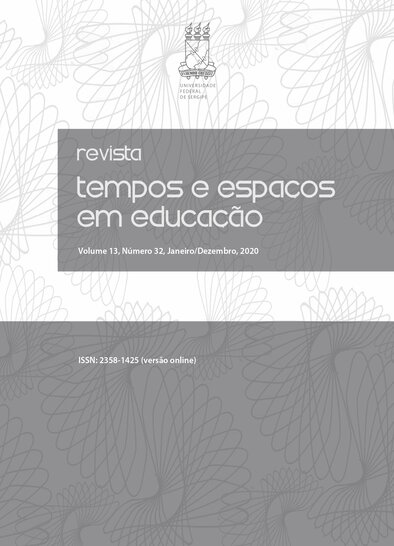The Effect of Intensive Authentic Reading Tasks on Reading Performance of Academic IELTS Test Takers
DOI:
https://doi.org/10.20952/revtee.v13i32.14447Palavras-chave:
Intensive reading; authentic materials; schema theory; reading comprehension instructional strategiesResumo
This study aimed at investigating the effect of employing intensive reading (IR) authentic tasks as supplementary materials on reading comprehension development of Academic IELTS test takers within the framework of schema theory and three instructional models of reading strategies suggested by Pearson and Duke (2009). Participants of this study consist of 81 individuals comprising 41 male and 40 female language learners at pre-advanced level of English proficiency with the age range of 25 to 37 among which 42 were categorized as the experimental group which received IR treatment and the rest of 39 ,who are considered as control group, that did not receive IR treatment. The experimental group was further divided into two subgroups which each received the same IR authentic tasks with different instructional methods to teaching reading strategies. The results of an ANCOVA analysis illustrated a significant positive influence of authentic IR treatments on the development of participants' reading comprehension skills. However, an independent one-way t-test revealed that Pearson's and Duke's (2009) various instructional methods were not significantly influential on participants' final reading proficiency development.
Downloads
Referências
Anderson, N. J. (1999). Exploring second language reading: Issues and strategies. Boston: Heinle & Heinle Publishers.
Block, C. & Israel, S. (2005). Reading first and beyond: The complete guide for teachers and literacy coaches. Thousand Oaks, CA: Corwin Press.
Boyacı, Ş. D., & Güner, M. (2018). The Impact of Authentic Material Use on Development of the Reading Comprehension, Writing Skills and Motivation in Language Course. International Journal of Instruction, 11(2), 351-368.
Brown, D. (1994) .Teaching by principles: an interactive approach to language pedagogy, Upper Saddle River, Prentice Hall Regents.
Coady J. (1979). A psycholinguistic model of the ESL reader in Reading in a second language. Rowley, mass:New-bu.5-12.
Ellis,G., Sinclair, & Barbara. (1994). Learning to leam English:A Course in learner training.. Cambridge: Cam-bridge University Press, 273.
Glisan, E. (2015). Core Practices Webinars. Alexandria, VA: ACTFL. Access at: https://www.pathlms.com/actfl/courses/2074The National Standards Collaborative Board. (2015). World-readiness standards for learning languages.
Harvey, S., & Goudvis, A. (2000). Strategies that work: Teaching comprehension to enhance understanding. Portland, ME: Stenhouse Publishers.
Hu, M., & Nation, I. S. P. (2000). Vocabulary density and reading comprehension. Reading in a Foreign Language, 13(1), 403-430.
Krashen, S. (1989). 'We acquire vocabulary and spelling by reading: Additional evidence for the Input Hypothesis'. Modern Language Journal.73/4: 440-62.
Khazaal, E. N. (2019). Impact of Intensive Reading Strategy on English for Specific
Purposes College Students' in Developing Vocabulary. Arab World English Journal, 10 (2) 181-195.
Long, M.H. & Richards, J.C. (1987). Methodology in TESOL, A Book of Readings, New York, NY: Newbury House
Macalister, J. (2010). Today's teaching, tomorrow's text: Exploring the teaching of reading. Elt Journal. 64. 10.1093/elt/ccq023.
Matsuda, A.(2018). Is Teaching English as an International Language All about Being Politically Correct? RELC Journal, 49(1) 24-35.
McLeod, P.(2017). The effect of language of instruction and contextual factors on higher order reading comprehension performance. Doctoral dissertation. Pretoria: University of Pretoria.
Nation, P. (2006). How large a vocabulary is needed for reading and listening? Canadian Modern Language Review, 63(1),
59-82.
Oczkus, L. D. (2003). Reciprocal teaching at work strategies for improving reading comprehension. Newark, DE: International Reading Association.
Paran,A.(2003). Intensive reading. English Teaching Professional, 28,P.40.
Palmer, H. (1921). The principles of language study, London,Harrap.
Peacock, M. (1997) The Effect of Authentic Materials on the Motivation of EFL Learners in
English Language Teaching Journal 51, pp 2Anderson R C R E Reynolds & D L Schallert. (1977). et al.Frameworks for comprehending discourse. American Edu-cational Research Journal, 14(4):369.
Rashidi,N. & Piran.,M.(2011). The Effect of Extensive and Intensive Reading on Iranian EFL Learners’Vocabulary Size and Depth. Journal of Language Teaching and Research, 2(2).471–482. 10.4304/jltr.2.2.471-482.
Richards, J.C., & Schmidt, R. (2002) Longman Dictionary of Language Teaching & Applied Linguistics (3rd edition). Essex: Pearson Education Limited.
Rumelbart, D. E. (1977) Toward an interactive model of reading. In S. Dornic (Ed.), Attention and performance VI. Hillsdale, N.J.: Erlbaum.
Serafini, F. (2004). Lessons in comprehension explicit instruction in the reading workshop. Portsmouth, NH: Heinemann.
Sevilla-Morales, H. (2017). Effects of scaffolded intensive reading on students’ reading comprehension performance. Actualidades Investigativas en Educación, 17(1), 96-125. https://dx.doi.org/10.15517/aie.v17i1.27204.
Shen, Y. (2008). An Exploration of Schema Theory in Intensive Reading. English Language Teaching, 1(2), 104-107.
Stahl, K. (2003). The effects of three instructional methods on the reading comprehension and content acquisition of novice readers. Paper presented at the meeting of the National Reading Conference, Scottsdale, AZ.
Teele, S. (2004).Overcoming barricades to reading a multiple intelligences approach. Thousand Oaks, CA: Corwin Press.
Thompson, I. (2002) Vocabulary Learning Strategies.
Vacca, R. T., & Vacca, J. L. (2002). Content area reading: Literacy and learning across the curriculum. Boston, MA: Allyn and Bacon.
Wallace, C. (2012) .Principles and practices for teaching English as an international language: teaching critical reading. In: Alsagoff L, McKay SL, Hu G, and Renandya W (eds) Principles and Practices for Teaching English as an International Language. New York: Routledge,261–81.
Widdowson H. G. (1983). Learning purpose and language use. London: Oxford University Press. 287.
Ying, L. (1998). Jingduke cihui jiaoxuetan [On teaching vocabulary in Intensive Reading]. Guowai waiyu jiaoxue, (2), 20-22.
Downloads
Publicado
Como Citar
Edição
Seção
Licença
À Revista Tempos e Espaços em Educação ficam reservados os direitos autorais pertinentes a todos os artigos nela publicados. A Revista Tempos e Espaços em Educação utiliza a licença https://creativecommons.org/licenses/by/4.0/ (CC BY), que permite o compartilhamento do artigo com o reconhecimento da autoria.



